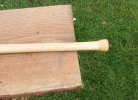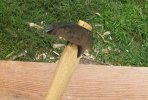Square_peg
Gold Member
- Joined
- Feb 1, 2012
- Messages
- 13,793
Here's something a little different. I found this miners drift pick at a local estate sale last year. Restoring it has been a work in progress for some time. I finally hung it today.
Here it is as it came to me last year. Rather than grind away metal to re-point this pick I decided to draw out the points on the anvil.

Heat up the forge.

One point done.

Back in for the other side. The neighbor's dog loves to watch me work.

Re-pointed pick.

Time to hang it. I ordered a new drift pick handle from House Handle.

One of House Handle's drift pick handles could be made to fit a double bit axe. Nice thing about them is that they come with no kerf. Like many of House's axe handles this handles eye is rotated out of line with the rest of the handle. I had to straighten it out to hang my pick true.

Here it is hung.

I did a little knob on the swell.

I fit the haft to the eye like I would a Jersey pattern axe.

Kinda weird, because of the shallow eye I had to cut the kerf deeper than the eye. I've never had to do that with an axe - not even a Hudson Bay.

I guess I should have used a wider wedge.

Hope you enjoy the photos.
Here it is as it came to me last year. Rather than grind away metal to re-point this pick I decided to draw out the points on the anvil.

Heat up the forge.

One point done.

Back in for the other side. The neighbor's dog loves to watch me work.

Re-pointed pick.

Time to hang it. I ordered a new drift pick handle from House Handle.

One of House Handle's drift pick handles could be made to fit a double bit axe. Nice thing about them is that they come with no kerf. Like many of House's axe handles this handles eye is rotated out of line with the rest of the handle. I had to straighten it out to hang my pick true.

Here it is hung.

I did a little knob on the swell.

I fit the haft to the eye like I would a Jersey pattern axe.

Kinda weird, because of the shallow eye I had to cut the kerf deeper than the eye. I've never had to do that with an axe - not even a Hudson Bay.

I guess I should have used a wider wedge.

Hope you enjoy the photos.
Last edited:









